7-31-09 - No sunspots today
Current conditions
Solar wind
speed: 410.2 km/sec
density: 2.5 protons/cm3
explanation |
more data
Updated: Today at
2345 UT
X-ray Solar Flares
6-hr max: A0
1850 UT Jul31
24-hr: A0
1850 UT Jul31
explanation |
more
data
Updated: Today at:
2340 UT
|
7-30-09 - No sunspots today
Current conditions
Solar wind
speed: 344.0 km/sec
density: 4.5 protons/cm3
explanation |
more data
Updated: Today at
2345 UT
X-ray Solar Flares
6-hr max: A0
2340 UT Jul30
24-hr: A0
2340 UT Jul30
explanation |
more
data
Updated: Today at:
2340 UT
CHANGES ON
JUPITER: "On July 30th, it was
evident that there is rapid evolution of Jupiter's
impact debris cloud," reports amateur astronomer
Raffaello Lena of Rome, Italy. "It is becoming very
elongated." A polar projection shows the extent of the
debris:
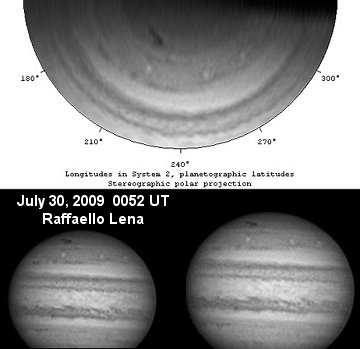
The changes are caused by turbulence and especially
high-altitude winds in Jupiter's atmosphere. Polar winds
blowing 25 m/s and faster could stretch the cloud all
the way around Jupiter's south pole in the weeks ahead.
Whether such a stretched-out cloud will be visible in
small telescopes remains to be seen.
Amateur astronomers are encouraged to continue
monitoring. The cloud is located near Jupiter's System
II longitude 210°. For the predicted times when it will
cross the planet's central meridian, add 2 hours and 6
minutes to Sky and Telescope's
predicted transit times for Jupiter's Great Red
Spot. [sky
map]
more images:
from Giovanni Coltro of Pesaro, Italy;
from Romulo Liporaci of Maracaibo, Venezuela;
from Sid Leach of Scottsdale, Arizona;
from Tamas Ladanyi of Bakonykoppany, Hungary;
from Efrain Morales Rivera of Aguadilla, Puerto
Rico;
from Andreas Murner of Lake Chiemsee, Bavaria,
Germany;
from John Chumack of Dayton, Ohio USA
|
7-29-09 - No sunspots today
Solar wind
speed: 353.9 km/sec
density: 2.2 protons/cm3
explanation |
more data
Updated: Today at
2346 UT
X-ray Solar Flares
6-hr max: A0
2340 UT Jul29
24-hr: A0
2340 UT Jul29
explanation |
more
data
Updated: Today at:
2340 UT

Solar wind stream flowing from
the
indicated coronal hole could
reach Earth on or about July 31st.
Credit:
SOHO Extreme UV Telescope
LUNAR
TRANSITS: Catching a spaceship
flying in front of the Moon is a rare trick. Yesterday,
Roman Piffl of Bratislava, Slovakia, caught two:

"First, space shuttle Endeavour
transited the Moon, followed a hundred
seconds later by the International Space
Station," says Piffl. Each crossing
lasted no more than a fraction of a
second, "but we were able to capture
them using a DMK21 video camera at 60
fps." Piffl was assisted by fellow
astronomers Tomáš Maruška and Miroslav
Grnja.Endeavour and the ISS will be
in orbit together for just one more day.
Check the
Simple Satellite Tracker for
last-chance flybys.
more images:
from Fox Keri of Marion,
Massachusetts;
from Todd Hahn of Sugar Land, Texas;
from Jonathan Sabin of Ellenton,
Florida;
from Michael Prokosch of Huntsville,
Texas
|
7-28-09 - No sunspots todayCurrent conditions
Solar wind
speed: 414.3 km/sec
density: 3.6 protons/cm3
explanation |
more data
Updated: Today at 1827 UT
X-ray Solar Flares
6-hr max: A0 1820
UT Jul28
24-hr: A0 1820 UT
Jul28
explanation |
more data
Updated: Today at: 1820 UT

A solar wind stream flowing from
the
indicated coronal hole could reach
Earth on or about July 31st.
Credit: SOHO Extreme UV Telescope
JUPITER'S IMPACT
CLOUD EXPANDS: Jupiter's impact cloud is
expanding. On July 19th, when it was
discovered by amateur astronomer Anthony Wesley, the dark
mark near Jupiter's south pole was barely visible in backyard
telescopes. Five days later Wesley photographed the impact cloud
again and found that it had approximately tripled in size:
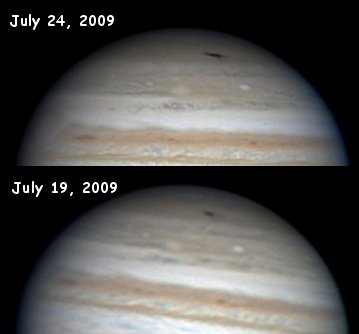
High-resolution images from the Hubble Space Telescope
reveal what's happening: turbulence and jet streams in Jupiter's
atmosphere are causing the cloud to spread out. The vast impact
site is now tens of thousands of times wider than the 100m-class
comet or asteroid that created it.
The expansion of the cloud makes it easier than ever to see
through a backyard telescope:
sky map. The cloud is located near Jupiter's System II
longitude 210°. For the predicted times when it will cross the
planet's central meridian, add 2 hours and 6 minutes to Sky and
Telescope's
predicted transit times for Jupiter's Great Red Spot.
more images:
from Mike Hood of Kathleen, Georgia;
from Didier Favre of Brétigny-sur-orge, France;
from Enzo De Bernardini of Martínez, Buenos Aires,
Argentina;
from Sadegh Ghomizadeh of Iran Tehran;
from David Kolb of Lawrence, Kansas;
|
7-27-09 - No sunspots today
Current conditions
Solar wind
speed: 388.2 km/sec
density: 4.2 protons/cm3
explanation |
more data
Updated: Today at
2346 UT
X-ray Solar Flares
6-hr max: A0
2340 UT Jul27
24-hr: A0
2340 UT Jul27
explanation |
more
data
Updated: Today at:
2340 UT
EARLY PERSEID
FIREBALL: Earth is
entering a stream of dusty debris from Comet
Swift-Tuttle, the source of the annual
Perseid meteor shower. Although the shower
won't peak until August 11th and 12th, the
show is already underway. Brian Emfinger of
Ozark, Arkansas, photographed this Perseid
just after midnight on Sunday, July 26th:

"I caught the fireball and its smoke
trail using my
Canon Digital Rebel XT," says Emfinger.
"It flew through the field of view during a
one minute exposure."
This early Perseid whets the appetite for
the greater show ahead. Meteor rates, low
now, will increase as Earth moves deeper
into the debris stream. On peak-night, sky
watchers could see more than 60 Perseids per
hour.
|
7-26-09 No sunspots today
Current conditions
Solar wind
speed: 410.2 km/sec
density: 3.0 protons/cm3
explanation |
more data
Updated: Today at
2345 UT
X-ray Solar Flares
6-hr max: A0
2340 UT Jul26
24-hr: A0
2340 UT Jul26
explanation |
more
data
Updated: Today at:
2340 UT
|
7-25-09 - small sunspot - unnumbered as yet Current conditions
Solar wind
speed: 489.5 km/sec
density: 2.0 protons/cm3
explanation |
more data
Updated: Today at 1346 UT
X-ray Solar Flares
6-hr max: A0 1340
UT Jul25
24-hr: A0 1340 UT
Jul25
explanation |
more data
Updated: Today at: 1340 UT
JUPITER SPOT SPREADING OUT

Hubble's view, captured by its brand-new Wide Field Camera 3 on
Thursday, is the sharpest visible-light image of the impact site,
which was first seen by Australian amateur astronomer Anthony
Wesley on Sunday and has been changing day by day. The picture
also represents Hubble's first science observation since it was
upgraded during May's
final servicing
mission by the space shuttle Atlantis' crew.
|
7-24-09 A small sunspot is developing half way across the face
of the sun. It is part of cycle 23 according to its magnetic spin.
It has not been numbered as yet
Solar wind
speed: 555.3 km/sec
density: 1.5 protons/cm3
explanation |
more data
Updated: Today at 1526 UT
X-ray Solar Flares
6-hr max: A0 1520
UT Jul24
24-hr: A0 1520 UT
Jul24
explanation |
more data
Updated: Today at: 1520 UT
JUPITER UPDATE:
Five days after it was discovered,
the dark mark in Jupiter's cloudtops where an asteroid or
comet hit the giant planet is still easy to see through
backyard telescopes. Browse these links for recent images:
#1,
#2,
#3,
#4,
#5,
#6.
Editor's note: These are clear photos but confusing
as to what they are trying to show.
|
7-23-09 - No sunspots today
Current conditions
Solar wind
speed: 497.6 km/sec
density: 3.9 protons/cm3
explanation |
more data
Updated: Today at 1555 UT
X-ray Solar Flares
6-hr max: A0 1545
UT Jul23
24-hr: A0 1545 UT
Jul23
explanation |
more data
Updated: Today at: 1545 UT

SOHO UNKNOWN
AURORA
SURPRISE: Sometimes the auroras are
so bright, you just can't sleep. "I was up all night on July
21st, but it was totally worth it!" says photographer Zoltan
Kenwell of Chip Lake, Alberta. This is what kept him awake:

"It was a very impressive show that lasted
4.5 hours!" says Kenwell.
Forecasters did not predict this display. It
began on when a seemingly minor solar wind stream hit
Earth's magnetic field. The minor hit turned into a
not-so-minor display because
a crack opened in Earth's magnetic field, allowing solar
wind to pour in and fuel the storm. Northern Lights
descended as far south as the Dakotas, Montana, Iowa and
Wisconsin. The solar wind is still blowing, but the crack
has closed, bringing an end to the lights. Until
next time, browse
the gallery:
UPDATED:
/gallery_01jul04_page3.htm?PHPSESSID=gsddenpm0vfgigj7vun15nq7q2">
2004 ,
2003]
TOTAL SOLAR
ECLIPSE: Chasing
an eclipse can be a nerve-wracking experience. Just ask
Alan Dyer, who on July 21st was sailing through the path of
totality in the south Pacific Ocean when clouds began to
gather overhead. "The early, partial stages of the eclipse
were blocked," says Dyer. "We had to chase into a clear hole
to catch this view of totality."
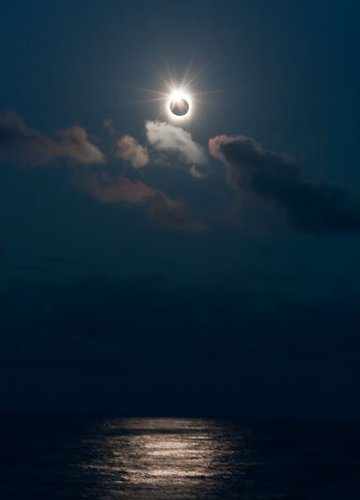
"The sight of the low-hanging Sun in eclipse was
spectacular with an impressively large Sun/Moon disk caused
by the 'moon illusion' effect," he says. "In the end, we
were a happy ship of 300 eclipse chasers!"
|
|
7-22-09

Eclipse 7-22-09
TOTAL
ECLIPSE: On Wednesday, July 22nd,
the Moon eclipsed the midday sun over China. "The
temperature dropped from 96.6 F to 88.5F at totality,"
reports Donald Gardner from Huangshan. "The roosters
were crowing and the streetlights came on!" He took this
picture of a sun-sliver beaming through lunar mountains:

Browse the gallery for more scenes from the path of
totality:
UPDATED:
July 22nd Eclipse Gallery
[previous eclipses:
Jan 26, 2009;
Aug. 1, 2008;
Mar. 19, 2007]
Current conditions
Solar wind
speed: 443.6 km/sec
density: 1.8 protons/cm3
explanation |
more data
Updated: Today at
2346 UT
X-ray Solar Flares
6-hr max: A0
2340 UT Jul22
24-hr: A0
0325 UT Jul22
explanation |
more
data
Updated: Today at:
2340 UT
AURORA
SURPRISE: In the pits of the
deepest solar minimum in a century, sky watchers had
almost forgotten what Northern Lights looked like. Here
they are last night over Lucky Lake, Saskatchewan:

"These are the first auroras I have been
able to photograph in more than a year," says Tenho
Tuomi. "It was a pleasant surprise."
The display was sparked by a solar wind
stream which hit Earth's magnetic field on July 21st.
The ensuing geomagnetic storm registered 6 on the 0 to 9
K-index scale of geomagnetic activity. "My magnetometer
picked up
the disturbance and I rushed outside to see the
show," says Tuomi.
July 2009 Northern Lights Gallery
|
7-21-09 - No sunspots today
Current conditions
Solar wind
speed: 307.6 km/sec
density: 11.0 protons/cm3
explanation |
more data
Updated: Today at
2346 UT
X-ray Solar Flares
6-hr max: A0
2340 UT Jul21
24-hr: A0
2340 UT Jul21
explanation |
more
data
Updated: Today at:
2340 UT
|
| 7-20-09 - No sunspots but major prominences have appeared
SOLAR ACTIVITY:
A
big
show
is
underway on the sun today. Two massive prominences are dancing along
the northwestern limb with such allure that the Solar and Heliospheric
Observatory (SOHO) has boosted its frame-rate to capture the motions.
Stay tuned for movies, and meanwhile, keep
an eye on the sun.
 2040 UT Jul20
2040 UT Jul20
explanation |
more
data
Updated: Today at:
2040 UT
|
7-19-09 - No sunspots today
Current conditions
Solar wind
speed: 283.9 km/sec
density: 3.5 protons/cm3
explanation |
more data
Updated: Today at
2346 UT
X-ray Solar Flares
6-hr max: A0
2340 UT Jul19
24-hr: A0
2340 UT Jul19
explanation |
more
data
Updated: Today at:
2340 UT
JUPITER IMPACT? On July 19th, a veteran observer of Jupiter in
Australia photographed a fresh dark "scar" in Jupiter's cloudtops; the
feature resembles the Shoemaker-Levy 9 impacts of 1994. It is possible
that Jupiter has been struck anew by an asteroid or comet.
Astrophotographers around the world should train their optics on Jupiter
to confirm the event and monitor its progress.
IMPACT ON
JUPITER? "Jupiter has been hit by
something similar to the
Shoemaker-Levy 9 impacts in 1994," reports
astrophotographer Anthony Wesley. "There is a jet black
circular impact mark near its south pole that I imaged
tonight from my observatory in Murrumbateman,
Australia." South is up in this snapshot of the feature:

"I have imagery of that same location from 2 nights
earlier without the impact mark so this is a very recent
event," he adds. "This image shows that the material has
already begun to spread out in a fan shape on one side,
and should be rapidly pulled apart by the fast jetstream
winds. I'm sure this will generate some interest around
the astronomy community, as impacts like this are rare.
I recorded a lot of footage, and will be generating more
images and a rotation animation."
Amateur astronomers around the world should train
their telescopes on Jupiter tonight to monitor the
progress of this possible impact event. Stay tuned for
more images and updates.
COSMIC
COLLISION: Evidence is mounting
that something hit Jupiter no more than a few days ago.
The impact site was
discovered by amateur astronomer Anthony Wesley on
July 19th. Using a 14.5-inch telescope at his backyard
observatory in Murrumbateman, Australia, he photographed
a
dark scar in Jupiter's clouds. NASA astronomers
rushed to confirm the find, and with this photo from the
Infrared Telescope Facility in Hawaii,
they did:

The bright spot is near-infrared sunlight reflected
from particulate matter floating through the top of
Jupiter's atmosphere. These particulates are likely
debris from something that hit the planet and exploded.
"This has all the hallmarks of the comet Shoemaker-Levy
9 impacts of 1994," says Leigh Fletcher of JPL who
gathered the infrared data along with colleague Glenn
Orton.
If the impact hypothesis is indeed correct, the
"scar" should become spread out by jet streams in the
days ahead. Amateur astronomers can monitor events using
mid-sized backyard telescopes:
sky map. The spot is located near Jupiter's System
II longitude 210°. For the predicted times when it will
cross the planet's central meridian, add 2 hours and 6
minutes to Sky and Telescope's
predicted transit times for Jupiter's Great Red
Spot.
UPDATE:
On July 20th, Dennis Simmons of Brisbane Australia
recorded a 75-minute movie of the impact site. Click on
the image to launch a gif animation:
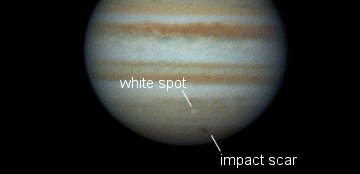
Play the movie
"It is quite fascinating to observe the white spot (a
Mars-sized storm) appearing to overtake the impact
scar," notes Simmons. "To make the movie I used a 7-inch
Takahashi Mewlon 180 telescope with a Vixen x2 Barlow
and a DBK21AF04 ccd camera."
more images:
from Antonello Medugno of Italy;
from Robert Lunsford of Chula Vista, California;
from Jeremy Perez of Flagstaff, Arizona;
from Theo Ramakers of Social Circle, Georgia;
from Anthony Wesley of Murrumbateman, Australia;
from Ian Sharp of Ham, West Sussex, England, UK;
from David Kolb of Lawrence, Kansas;
from David Storey of Isle of Man, Great Britain;
from Frank Ryan Jr of Shannon, Ireland;
from Russell Hawker of Eastleigh, Hampshire;
from Lars Zielke of Tvis, Denmark; <
24-hr: A1
0155 UT Jul18
explanation |
more
data
Updated: Today at:
2340 UT
|
7-17-09 - No sunspots today
Current conditions
Solar wind
speed: 312.5 km/sec
density: 1.9 protons/cm3
explanation |
more data
Updated: Today at
2347 UT
X-ray Solar Flares
6-hr max: A0
2340 UT Jul17
24-hr: A0
0635 UT Jul17
explanation |
more
data
Updated: Today at:
2340 UT
APOLLO
LANDING SITES PHOTOGRAPHED:
NASA's Lunar Reconnaissance Orbiter has returned its
first imagery of Apollo landing sites. The pictures show
lunar module descent stages, scientific instruments and
even 40-year-old foot trails made by astronauts walking
across the dusty lunar surface:
full story.
July 17th, 2009
Written by
Anne Minard
Researchers have discovered a link
between the 11-year
solar cycle and tropical Pacific weather
patterns that resemble La Niña and El Niño
events.When it comes to
influencing
Earth's climate,
the Sun's variability pales in recent
decades compared to greehouse gases – but
the new research shows it still plays a
distinguishable part.
The total energy reaching Earth from
the sun varies by only 0.1 percent across
the solar cycle. Scientists have sought for
decades to link these ups and downs to
natural weather and climate variations and
distinguish their subtle effects from the
larger pattern of human-caused global
warming.
Co-authors Gerald Meehl and Julie
Arblaster, both affiliated with the National
Center for Atmospheric Research in Boulder,
Colorado, analyzed computer models of global
climate and more than a century of ocean
temperature records. Arblaster is also
affiliated with the Australian Bureau of
Meteorology.
In the new paper and a previous one
with additional colleagues, the researchers
have been able to show that, as the sun's
output reaches a peak, the small amount of
extra sunshine over several years causes a
slight increase in local atmospheric
heating, especially across parts of the
tropical and subtropical Pacific where
Sun-blocking clouds are normally scarce.
That small amount of extra heat leads
to more evaporation, producing extra water
vapor. In turn, the moisture is carried by
trade winds to the normally rainy areas of
the western tropical Pacific, fueling
heavier rains.
As this climatic loop intensifies, the
trade winds strengthen. That keeps the
eastern Pacific even cooler and drier than
usual, producing La Niña-like conditions.
"We have fleshed out the effects of a
new mechanism to understand what happens in
the tropical Pacific when there is a maximum
of
solar activity," Meehl said. "When the
sun's output peaks, it has far-ranging and
often subtle impacts on tropical
precipitation and on weather systems around
much of the world."
The result of this chain of events is
similar to a La Niña event, although the
cooling of about 1-2 degrees Fahrenheit is
focused further east and is only about half
as strong as for a typical La Niña.
True La Niña and El Niño events are
associated with changes in the temperatures
of surface waters of the eastern Pacific
Ocean. They can affect weather patterns
worldwide.
Although the Pacific pattern in the
new paper is produced by the
solar maximum, the authors found that
its switch to an El Niño-like state is
likely triggered by the same kind of
processes that normally lead from La Niña to
El Niño.
The transition starts when the changes
of the strength of the trade winds produce
slow-moving off-equatorial pulses known as
Rossby waves in the upper ocean, which take
about a year to travel back west across the
Pacific.
The energy then reflects from the
western boundary of the tropical Pacific and
ricochets eastward along the equator,
deepening the upper layer of water and
warming the ocean surface.
As a result, the Pacific experiences
an El Niño-like event about two years after
solar maximum — also about half as strong as
a true El Niño. The event settles down after
about a year, and the system returns to a
neutral state.
"El Niño and La Niña seem to have
their own separate mechanisms," Meehl said,
"but the solar maximum can come along and
tilt the probabilities toward a weak La
Niña. If the system was heading toward a La
Niña anyway," he adds, "it would presumably
be a larger one."
The study authors say the new research
may pave the way toward predictions of
temperature and precipitation patterns at
certain times during the approximately
11-year solar cycle.
In an email, Meehl noted that previous
work by his team and other research groups
has shown that "most of the warming trend in
the first half of the 20th Century was due
to an increasing trend of solar output,
while most of the warming trend in the last
half of the 20th Century and ever since has
been due to ever-increasing GHG (greenhouse
gas) concentrations in the atmosphere from
the burning of fossil fuels."
The new paper appears this month in
the Journal
of Climate, a publication of the
American Meteorological Society.
(Sorry, it's not yet available online.)
Source:
Eurekalert
Related stories on
Universe Today
|
7-16-09 - No sunspots today
Current conditions
Solar wind
speed: 355.4 km/sec
density: 2.9 protons/cm3
explanation |
more data
Updated: Today at
2347 UT
X-ray Solar Flares
6-hr max: A0
2340 UT Jul16
24-hr: A0
2340 UT Jul16
explanation |
more
data
Updated: Today at:
2340 UT

A solar wind stream flowing from
the indicated coronal hole should
reach Earth on or about July 21.
Credit: SOHO Extreme UV Telescope
|
7-15-09 - No sunspots today
Current conditions
Solar wind
speed: 433.3 km/sec
density: 2.1 protons/cm3
explanation |
more data
Updated: Today at 2145 UT
X-ray Solar Flares
6-hr max: A0 2145
UT Jul15
24-hr: A0 2145 UT
Jul15
explanation |
more data
Updated: Today at: 2145 UT
NOTE: Whether we went to the
moon or not has been a big controversy, even this week, I was in several
conversations about this topic. Was it real or wasn't it?
There are proponents and adversaries on this issue. I doubt anyone wants
to believe that we really didn't go and that it was all a hoax and that
our government has been lying to us about it all this time.
I've done webpages on this
issue myself. I've had heated arguments about it as well and listened to
numerous radio shows and television documentaries.
The truth is about to come out,
thanks to Mrs. Stanley Kubrick, whose husband's company made the fake
film of the moon landing in case the camera didn't work for the
astronauts on the moon. Her film is about to be brought to the
public and will the answer the question once and for all. All
those men who were involved in the coverup film have already been named
and all that is already in the public domain.
The only question left is,
"Did we really go? Or is it a lie?"
-
NASA's
Dr. John Freeman reported that instruments left on the
moon
by Apollo ...... --Richard
Nixon:
President who addressed Armstrong and Aldrin on the
moon
..... The
Moon crash-landing
was the last stage of the 16-month phase in which ...
www.greatdreams.com/moon/darkmoon.htm
|
Wide Awake in the Sea of Tranquillity |
07.15.2009
|
|
Neil
Armstrong was supposed to be asleep. The moonwalking was done. The
moon rocks were stowed away. His ship was ready for departure. In
just a few hours, the Eagle's ascent module would blast off the
Moon, something no ship had ever attempted before, and Neil needed
his wits about him. He curled up on the Eagle's engine cover and
closed his eyes.
 But
he could not sleep. But
he could not sleep.
Neither could Buzz Aldrin. In the cramped lander, Buzz had the sweet
spot, the floor. He stretched out as much as he could in his
spacesuit and closed his eyes. Nothing happened. On a day like this,
what else could you expect...?
Right: Neil Armstrong's footprint on the Moon.
July 20, 1969: The day began on the farside of the
Moon. Armstrong, Aldrin and crewmate Mike Collins flew their
spaceship 60 miles above the cratered wasteland. No one on Earth can
see the Moon's farside. Even today it remains a land of considerable
mystery, but the astronauts had no time for sight-seeing. Collins
pressed a button, activating a set of springs, and the spaceship
split in two. The half named Columbia, with Collins on board, would
remain in orbit. The other half, the Eagle, spiraled over the
horizon toward the Sea of Tranquillity.
"You are
Go for powered descent," Houston radioed, and the Eagle's
engine fired mightily. The bug-shaped Eagle was so fragile a child
could poke a hole through its gold foil exterior. Jagged moonrocks
could do much worse. So when Armstrong saw that the computer was
guiding them into a boulder field, he quickly took control. The
Eagle pitched forward and sailed over the rocks.
Meanwhile, alarms were ringing in the background.
"Program alarm," announced Armstrong. "It's a 1202." The code was so
obscure, almost no one knew what it meant. Should they abort? Should
they land? "What is it?" he insisted.
Scrambling back in Houston, a young engineer named Steve Bales
produced the answer: The radar guidance system was pestering the
computer with too many interruptions. No problem. "We've got you..."
radioed Houston. "We're Go on that alarm."
And on they went. Things, however, were not going exactly as
planned. The Sea of Tranquillity was supposed to be smooth, but it
didn't look so smooth from the cockpit of the Eagle. Armstrong
scanned the jumbled mare for a safe place to land. "60 seconds,"
radioed Houston. "30 seconds." Mission control was hushed as the
telemetry came in. Soon, too soon, the ship would run out of fuel.
 Right:
Mission Control during the Apollo 11 descent. [More] Right:
Mission Control during the Apollo 11 descent. [More]
Capcom later claimed the "boys in mission control were turning blue"
when Armstrong announced "I [found] a good spot." As for Armstrong,
his heart was thumping 156 beats per minute according to
bio-sensors. The fuel gauge read only 5.6% when the Eagle finally
settled onto the floor of the Sea of Tranquillity.
Houston (relieved): "We copy you down, Eagle."
Armstrong (coolly): "Houston, Tranquility Base here. The Eagle has
landed."
Immediately, they prepared to leave. This was NASA being cautious.
No one had ever landed on the Moon before. What if a footpad started
sinking into the moondust, or the Eagle sprung a leak? While Neil
and Buzz made ready to blast off, Houston read the telemetry looking
for signs of trouble. There were none, and three hours after
touchdown, finally, Houston gave the "okay." The moonwalk was on.
At
9:56 p.m. EDT, Neil descended the ladder and took "one small step"
(left foot first) into history. From the shadow of the Eagle, he
looked around: "It has a stark beauty all its own--like the high
desert of the United States." Houston reminded him to gather the
"contingency sample," and Neil put some rocks and soil in his
pocket. If, for any reason, the astronauts had to take off in a
hurry, scientists back on Earth would get at least a pocketful of
the Moon for their experiments.
Soon,
Buzz joined him. "Beautiful view!" he exclaimed when he reached the
lander's broad footpad. "Isn't that something!" agreed Armstrong.
"Magnificent sight out here."
"Magnificent desolation," said Aldrin.
Those
two words summed up the yin-yang of the Moon. The impact craters,
the toppled boulders, the layers of moondust--it was utterly alien.
Yet Tranquillity Base felt curiously familiar, like home. Apollo
astronauts on subsequent missions had similar feelings. Maybe this
comes from staring at the Moon so often from Earth. Or maybe it's
because the Moon is a piece of Earth, spun off our young planet
billions of years ago. No one knows; it just is.

Above: Buzz Aldrin and the Eagle. [In
stereo]
Truly,
much of the scene was weird. The airless landscape jumped out at the
astronauts with disconcerting clarity and, as a result, the horizon
felt unnaturally close. The whole world seemed to curve, a
side-effect of the Moon's short thousand-mile radius. "Distances
[here] are deceiving," noted Aldrin.
The
sky was equally baffling. Although the Eagle had landed on a bright
lunar morning, the sky was as black as midnight. An astronomer's
paradise? No. Not a single star was visible. The glaring, sunlit
ground ruined the astronaut's night vision. Only Earth itself was
bright enough to be seen, luminous blue and white, hanging overhead.
Armstrong was particularly fascinated by moondust, which he kicked
and scuffed with his boots. On Earth, kicking dust makes a little
cloud in the air--but there is no air on the Moon. "When you kick
the surface, [the dust goes out in] a little fan which, to me, is in
the shape of a rose petal," recalls Armstrong. "There's just a
little ring of particles--nothing behind 'em--no dust, no swirl, no
nothing. It's really unique."
Enough of that. It was time for work.
Almost forgotten in Apollo lore are the
checklists sewn to the forearms of the spacesuits. These
"honey-do" memos from NASA were jam-packed with activities--from
inspecting the lander to deploying the TV to collecting samples.
Some of the tasks were as detailed as bending over and reporting to
Mission Control how it went. They had a lot to do.
 Neil
and Buzz deployed a solar wind collector, a seismometer and a laser
retroreflector. They erected a flag and uncovered a plaque
proclaiming, "We came in peace for all mankind." They took the first
interplanetary phone call--"I just can't tell you how proud we all
are," said President Nixon from the Oval Office. They collected 47
lbs of moon rocks and took 166 pictures. Check. Check. Check. Neil
and Buzz deployed a solar wind collector, a seismometer and a laser
retroreflector. They erected a flag and uncovered a plaque
proclaiming, "We came in peace for all mankind." They took the first
interplanetary phone call--"I just can't tell you how proud we all
are," said President Nixon from the Oval Office. They collected 47
lbs of moon rocks and took 166 pictures. Check. Check. Check.
Right: Buzz Aldrin totes experiments from the Eagle onto
the lunar surface. [More]
Finally,
after two and a half busy, exhilarating hours, it was time to go.
The checklist continued: Climb back in the Eagle. Stow the rocks.
Eat dinner: Beef stew or cream of chicken soup. And finally, sleep.
That was
the limit. "You just are not going to get any sleep while you're
waiting [for liftoff]," Aldrin said after the mission.
The
Eagle was not a sleepy place. The tiny cabin was noisy with pumps
and bright with warning lights that couldn't be dimmed. Even the
window shades were glowing, illuminated by intense sunshine outside.
"After I got into my sleep stage and all settled down, I realized
there was something else [bothering me]," said Armstrong. The Eagle
had an optical telescope sticking out periscope-style. "Earth was
shining right through the telescope into my eye. It was like a light
bulb."
To get
some relief, they closed the helmets of their spacesuits. It was
quiet inside and they "wouldn't be breathing all the dust" they had
tramped in after the moon walk, said Aldrin. Alas, it didn't work.
The suit's cooling systems, so necessary out on the scorching lunar
surface, were too cold for sleeping inside the Eagle. The best
Aldrin managed was a "couple hours of mentally fitful drowsing."
Armstrong simply stayed awake.
When the
wake-up call finally came,
"Tranquility Base, Tranquility Base, Houston. Over."
Armstrong answered with alacrity,
"Good
morning, Houston. Tranquility Base. Over."
It
was time to go home, to Earth, for a good night's sleep. |
|
7-14-09 - No sunspots today
Current conditions
Solar wind
speed: 493.9 km/sec
density: 2.6 protons/cm3
explanation |
more data
Updated: Today at
2346 UT
X-ray Solar Flares
6-hr max: A0
2340 UT Jul14
24-hr: A0
0955 UT Jul14
explanation |
more
data
Updated: Today at:
2340 UT

NLCs INVADE THE USA:
So far in 2009,
noctilucent clouds (NLCs) have been seen
mainly over Europe and parts of Canada, but
now they are beginning to invade the
continental USA. "We had a pretty good
dispay in Grass Valley, Oregon, last night,"
reports amateur astronomer Dan Earl. "I've
been looking for NLCs for the past couple of
years and finally they arrived!" He took
these pictures using a
Canon 40D. US sky watchers should be
alert for electric blue.
|
7-13-09 - No sunspots today
Current conditions
Solar wind
speed: 464.8 km/sec
density: 4.9 protons/cm3
explanation |
more data
Updated: Today at
2346 UT
X-ray Solar Flares
6-hr max: A0
2340 UT Jul13
24-hr: A0
2340 UT Jul13
explanation |
more
data
Updated: Today at:
2340 UT
COLORADO FIREBALL:
"A
fireball of magnitude -10 (about 250
times brighter than Venus) lit up central
Colorado at 2:28 a.m. MDT on July 13th,"
reports astronomer Chris Peterson of Guffey,
Colorado. "It was very slow, lasting at
least 5.5 seconds." Triangulating sightings
from Colorado and New Mexico, he estimates
that the meteoroid was "only 50 km high and
traveling about 15 km/s. The fairly low
altitude and low velocity mean this fireball
might have produced meteorites." [more
information]
|
| 7-12-09 - No sunspots today
Current conditions
Solar wind
speed: 399.3 km/sec
density: 2.8 protons/cm3
explanation |
more data
Updated: Today at 0536 UT
X-ray Solar Flares
6-hr max: A1 0005
UT Jul12
24-hr: A1 0005 UT
Jul12
explanation |
more data
Updated: Today at: 0530 UT

Earth is inside a solar wind stream
flowing from the indicated coronal
hole.
Credit: SOHO Extreme UV Telescope |
| 7-11-09 - - sunspot 1024 is rotating around the corner of the sun
and disappearing from view
AROUND THE
BEND: The biggest sunspot in two
years, sunspot 1024, has rotated over the sun's western
limb and is no longer visible from Earth. But that
doesn't mean the sunspot has disappeared. Here it is in
an ultraviolet photo taken just a few hours ago by
NASA's STEREO-A
spacecraft:

STEREO-A is stationed over the sun's western horizon
where it can monitor sunspots
no longer visible from Earth. The spacecraft will
track sunspot 1024 for as much as four more days,
gathering valuable data on the sunspot's rate of growth
or decay. Indeed, if the sunspot can hold itself
together for only two more weeks, the sun's rotation
will carry it around to face Earth once again. Stay
tuned for updates from around the bend.
Current conditions
Solar wind
speed: 402.4 km/sec
density: 3.0 protons/cm3
explanation |
more data
Updated: Today at
2345 UT
X-ray Solar Flares
6-hr max: A2
2335 UT Jul11
24-hr: A2
2335 UT Jul11
explanation |
more
data
Updated: Today at:
2340 UT
|
7-10-09 - Sunspot 1024 is leaving view shortly
GOOD-BYE
SUNSPOT 1024: The biggest, most
active sunspot in two years is about to disappear.
Sunspot 1024 is approaching the sun's western limb and,
later today, it will go around the bend. Pavol Rapavy
sends this photo from Rimavska Sobota, Slovakia:

Readers with
solar telescopes should train their optics on the
edge of the sun. Even minor eruptions from sunspot 1024
could hurl photogenic blobs of hot plasma high over the
limb where they would shine in beautiful relief against
the black of space beyond. The parting shots could be
the best of all.
more images:
from Cai-Uso Wohler of Bispingen, Germany;
from David B.V. Tyler of Buckinghamshire UK;
from D. Booth, T. Emerson, J .Stetson of South
Portland, Maine;
from Andy Yeung of Hong Kong;
from Stephen Yeathermon of Santa Fe, Texas;
Current conditions
Solar wind
speed: 434.7 km/sec
density: 2.8 protons/cm3
explanation |
more data
Updated: Today at
2346 UT
X-ray Solar Flares
6-hr max: A0
2340 UT Jul10
24-hr: A4
1040 UT Jul10
explanation |
more
data
Updated: Today at:
2340 UT
|
|
Moonship
Photographed by Backyard Astronomers
July 9, 2009:
On June 29th, neighbors of
Paul Mortfield in Ontario, Canada, heard "cheers of
excitement" coming from the astronomer's house. What caused
the commotion?
"I had just observed NASA's LCROSS spacecraft," explains
Mortfield. Using no more than a backyard telescope, he
caught it zipping past spiral galaxy IC3808:

Above:
LCROSS photographed on June 29,
2009, by Paul Mortfield using a remotely-operated 16-inch
telescope. The spacecraft was about 480,000 km from Earth.
LCROSS is the Lunar Crater Observation and Sensing
Satellite. It left Earth June 18th atop an Atlas V rocket on
a mission to crash into the Moon. On Oct. 9th, NASA plans to
plunge LCROSS headfirst into a deep crater near the Moon's
south pole. Researchers hope the debris it kicks up will
reveal water and other minerals of use to future lunar
explorers.
Meanwhile, LCROSS is circling the Earth-moon system in a
long looping orbit, and NASA is inviting amateur astronomers
to help track it.
There
were definitely cheers of excitement around the house when I
saw it on the computer screen."
Mortfield estimates the brightness of the spacecraft to be
16th magnitude, similar to that of many near-Earth
asteroids. To find it, he recommends pointing your web
browser at JPL's online Horizons ephemeris system (link)
and entering 'LCROSS' as the target body. The program will
generate a set of coordinates you can plug into the tracking
system of almost any modern backyard telescope.
Since Mortfield first caught sight of LCROSS on June 29th,
others have seen it too. Portuguese amateur Paulo Lobao
photographed LCROSS using a refracting telescope only
4-inches in diameter:
details.
"Today's technology is truly amazing, allowing amateurs to
capture images far beyond what professionals were doing just
a couple of decades ago," says Mortfield.
Indeed, says Day, LCROSS is a fairly easy target for
experienced amateurs, and he'd love nothing better than to
recruit hundreds of observers to keep track of LCROSS in the
months ahead. How does an astronomer get started? "Go to the
LCROSS observer's group (link).
Start reading the articles and chatting with other
observers," he suggests.
The really big event comes in October when LCROSS crashes
into the Moon. Amateur astronomers will be able to observe
that, too.
|
| 7-9-09 - sunspot 1024 continues to move across the sun.

The Solar and Heliospheric
Observatory (SOHO) has captured satellite images of what
appears to be a UFO entering into the sun after a solar
flare. The flare was part of a series that had been
predicted by a crop circle. The Milk Hill crop circle
evolved over
three stages from June 21-30. It had a
coded message predicting solar activity in the form of
Coronal Mass Ejections (CMEs) beginning on July 6/7. The UFO
is not a planet and does not have the characteristics of a
comet both of which are regularly captured on SOHO images.
The UFO is seen moving through a solar flare
that appeared on July 9 after a CME is ejected.
With the large amount of interest generated in the crop
circle prediction, the UFO may have been related in some
way.
SUNSPOTS FOR
BREAKFAST: "Today, when I looked at
sunspot 1024 through my
Coronado H-alpha filter, the active region reminded me of
two enormous breaking egg yokes," reports Larry Alvarez of
Flower Mound, Texas. "There were long snakelike arms reaching
from one yoke to the next in an egg-citing tug of war." He calls
this snapshot Sunspots for Breakfast:

Breakfast is almost over. Sunspot 1024 is approaching the
sun's western limb where it will disappear in 24 hours. That
will bring an end to the best display of sunspots in nearly two
years. Fortunately for astrophotographers, sunspot 1024 is a
member of new Solar Cycle 24 and it probably heralds more to
come. Solar activity is not eggs-tinct, after all.
more images:
from David B.V. Tyler of Buckinghamshire UK;
from K.Greene, G. Harmon and J.Stetson of South Portland,
Maine;
from Juan Miguel González Polo of Cáceres, Spain;
from Jan Timmermans of Valkenswaard, The Netherlands;
from Marco Vidovic of Stojnci, Slovenia;
from Steve Boyce of Sidmouth Devon, UK;
from Paul Haese of Blackwood, South Australia;
from Pete Lawrence of Selsey, West Sussex, UK;
from Fulvio Mete of Rome, Italy;
from Stefano Sello of Pisa, Italy;
from Andy Yeung of Hong Kong;
from John Nassr of Baguio, Philippines;
from Ehsan Rostamizadeh of Kerman, Iran;
Current conditions
Solar wind
speed: 374.5 km/sec
density: 12.4 protons/cm3
explanation |
more data
Updated: Today at 2145 UT
X-ray Solar Flares
6-hr max: A0 1930
UT Jul09
24-hr: A0 1320 UT
Jul09
explanation |
more data
Updated: Today at: 2145 UT
|
| 7-8-09 - sunspot 1024 - growing again
RESURGENT SUNSPOT:
Yesterday, sunspot 1024 took the day off;
the fast-growing active region stopped growing and even decayed
a little. Today, the sunspot is growing again. It now measures
125,000 km from end to end, almost as wide as the planet
Jupiter. This 3-day movie from the Solar and Heliospheric
Observatory (SOHO) shows recent developments:

The size of the spot makes it a fine target for backyard
solar telescopes. And it is worth watching. Sunspot
1024 is the first big sunspot of new Solar Cycle 24, and
it is crackling with minor but photogenic
B-class flares. By itself, this one active region
won't bring an end to the deepest solar minimum in a
century, but it does show that the sun's magnetic dynamo
is still working--a fact some had begun to doubt. More
sunspots are coming, so stay tuned.more
images:
from John Nassr of Baguio, Philippines;
from Ehsan Rostamizadeh of Kerman, Iran;
from Pavol Rapavy of Observatory Rimavska Sobota,
Slovakia;
from Steve Wainwright of Swansea South Wales, UK;
from Keith Davies of Swansea, South Wales, United
Kingdom;
from David Leong of Hong Kong;
Solar wind
speed: 318.8 km/sec
density: 5.6 protons/cm3
explanation |
more data
Updated: Today
at 1707 UT
X-ray Solar Flares
6-hr max: A2
1140 UT Jul08
24-hr: B3
0530 UT Jul08
explanation |
more data
Updated: Today
at: 1700 UT
|
| 7-7-09 - Sunspot 1024 subsiding in intensity -bigger than
earth Scientists and astronomers must be seeing something
different in this sunspot because they don't agree:
SUBSIDING SUNSPOT: Sunspot
1024 is experiencing some decay and solar flare activity is subsiding.
Nevertheless, by recent standards it is still a behemoth. "Now
approaching the western limb, the region provides a tremendous richness
of detail through amateursolar
telescopes," says Pete Lawrence who sends this picture from his
backyard observatory in Selsey UK:

Many readers are writing to ask if this sunspot is going to produce a
major solar storm today, July 7th. Such a storm was "predicted"
by a set of crop circles in England, and the solar blogosphere has been
abuzz with speculation. The answer is "no." A major storm is not in the
offing. Sunspot 1024 is relatively large, but it does not have the kind
of complex magnetic field that poses a threat for major eruptions. Crop
circles, it turns out, are not a useful tool for forecasting solar
activity.
more images: from
Mike Borman of
Evansville, Indiana; from
Stuart Thomson of
Melbourne, Australia; from
Fulvio Mete of Rome,
Italy;from
Mustafa Erol of Antalya,
Turkey; from
Raffaele Filannino of
Barletta, Puglia, Italia; from
Gary Colwell of Ardooch
Ontario; from
Tom Jorgenson of Neenah,
Wisconsin; from
Therese van Nieuwenhoven of
Laukvik, Lofoten islands, Norway; from
T. Emerson and J. Stetson of
South Portland, Maine; from
Pavol Rapavy of
Observatory Rimavska Sobota, Slovakia;
ASTRONOMERS are claiming that Earth is
witnessing the biggest and most powerful Sunspot ever seen and the
sunspot is yet to peak in intensity.
A sunspot is a magnetic storm on the surface of the sun and the area of
the spot is colder than the normal surface.
The normal surface is about 5000 degrees, the temperature of a sunspot
is about 3000 degrees.
The size of a sunspot varies, ranging from the size of the moon to 65
times larger than the size of earth and lasts for about a month then
fades away.
This newest sunspot is thought to be 60 to 80 times the size of Earth
and has occurred on the side of the sun, which is in view of Australia.
Wappa Falls Observatory head astronomer Owen Bennedick describes the
sunspot shape like the letter S and thinks it to be approximately
150,000 km long and 30,000 km wide.
“It's flares have not yet been measured,” Owen Bennedick said, “but it
is like hundreds of thousands of hydrogen bombs.”
The flares have been so bright that NASA has had trouble taking accurate
pictures of the sunspot.
Mr Bennedick said the sunspot is still growing in intensity but predicts
it could climax by today.
The sunspot will cause the Earth's atmosphere to heat up, potentially
creating problems to powerlines, radio transmitters and delicate
equipment such as mobile phones and computers.
Mr Bennedick suggests powerline filters be installed on computers and
people should put on extra sunscreen.
Sunspots appear on the sun in cycles, occurring every 11 years, the
current cycle has four years until it reaches it peak.
The last sunspot happened two years ago and was the most powerful flare
yet measuring x28.
Most sunspot flares measure around x12 which is still considered
powerful.
The Sunspot two years ago was 45 times larger than the earth and lasted
for 45 days.
Since that sunspot, no more had been seen until Sunday, this latest one
considered the most powerful yet.
The Wappa Falls Observatory is in the process of installing a new 12
inch telescope which will allow a greater view of the sky.
The new telescope was bought in honour of Kerry Mounter who recently
passed away.
Mr Mounter was an inspiration to all who worked at the Wappa Falls
Observatory. The telescope will be dedicated to his memory.
Current conditions
Solar wind
speed: 336.4 km/sec
density: 9.8 protons/cm3
explanation | more
data
Updated: Today at 1846 UT
X-ray Solar Flares
6-hr max: A9 1700
UT Jul07
24-hr: A9 1700
UT Jul07
explanation | more
data
Updated: Today at: 1840 UT |
7-6-09 - Sunspot 1024 continues
Current conditions
Solar wind
speed: 366.2 km/sec
density: 1.6 protons/cm3
explanation |
more data
Updated: Today at 2346 UT
X-ray Solar Flares
6-hr max: A3 2035
UT Jul06
24-hr: B8 1705 UT
Jul06
explanation |
more data
Updated: Today at: 2345 UT
|
| 7-5-09 - Sunspot 1024
SUDDEN SUPER
SUNSPOT: Sunspot 1024 is crackling with
B- and C-class solar flares. The activity is so intense,
astronomers can't seem to take a picture of the sunspot without
catching a flare in action. Pete Lawrence sends this example
from his backyard observatory in Selsey, UK:

"Active
region 1024 is putting on a fantastic show," says Lawrence. "The
center of this region is incredibly bright and fluctuating."
Solar observers haven't seen an active region like this one
in more than two years. It is big, complex, and rapidly growing:
movie. The magnetic polarity of the sunspot, revealed by
SOHO magnetograms, show that it is a member of new Solar Cycle
24. This makes sense: New research shows that
solar jet streams are beginning to stimulate new-cycle
sunspot production. Sunspot 1024 appears to be a sign of the
process at work, heralding more to come.
Monitoring is encouraged.
more images:
from Anthony Ayiomamitis of Athens, Greece;
from Didier Favre of Brétigny-sur-Orge, France;
from Cai-Uso Wohler of Bispingen, Germany;
from Pavol Rapavy of Observatory Rimavska Sobota, Slovakia;
from Steve Wainwright of Swansea, S. Wales UK;
from Jan Timmermans of Valkenswaard, The Netherlands;
from Mark Townley of Brierley Hill, West Midlands, UK;
from David B.V. Tyler of southern England;
from Brian Woosnam of In North Wales UK;
from Lecoq Etienne of Mesnil Panneville Normandy ,France;
from Florin Marc of Tirgu Mures, Romania
The Classification of X-ray Solar Flares
or "Solar Flare Alphabet Soup"
A
solar flare is an explosion on the Sun that happens when
energy stored in twisted magnetic fields (usually above
sunspots) is suddenly released. Flares produce a burst of
radiation across the electromagnetic spectrum, from radio
waves to x-rays and gamma-rays. [more
information]
Scientists classify solar flares according to their x-ray
brightness in the wavelength range 1 to 8 Angstroms. There are
3 categories: X-class flares are big; they are major
events that can trigger planet-wide radio blackouts and
long-lasting radiation storms. M-class flares are
medium-sized; they can cause brief radio blackouts that affect
Earth's polar regions. Minor radiation storms sometimes follow
an M-class flare. Compared to X- and M-class events,
C-class flares are small with few noticeable consequences
here on Earth.
This figure shows a series of solar flares detected by NOAA
satellites in July 2000:
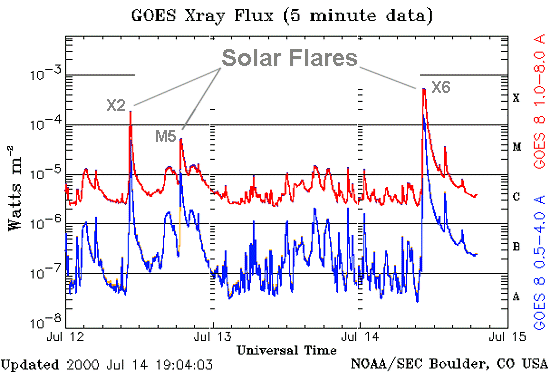
Each category for x-ray flares has nine subdivisions ranging
from, e.g., C1 to C9, M1 to M9, and X1 to X9. In this
figure, the three indicated flares registered (from left to
right) X2, M5, and X6. The X6 flare triggered a radiation
storm around Earth nicknamed the
Bastille Day event.
|
Class |
Peak (W/m2)between 1 and 8 Angstroms
|
|
B |
I < 10-6 |
|
C |
10-6 < = I < 10-5
|
|
M |
10-5 < = I < 10-4
|
|
X |
I > = 10-4
|
Current conditions
Solar wind
speed: 336.4 km/sec
density: 1.1 protons/cm3
explanation |
more data
Updated: Today at 1825 UT
X-ray Solar Flares
6-hr max: B3 1250
UT Jul05
24-hr: C1 0710 UT
Jul05
explanation |
more data
Updated: Today at: 1825 UT
|
| 7-4-09 - Sunspot -1024
 
ceweather.com/images2009/04jul09/1024_anim.gif?PHPSESSID=ar45r7tl5v3ichc5r9f20mchv2">
movie. Sunspot 1024 has at least a dozen individual dark
cores and it is crackling with
B-class solar flares. This morning, amateur astronomer David
Tyler caught one of the flares in action from his backyard solar
observatory in England:
The magnetic polarity of sunspot 1024 identifies it as a
member of new Solar Cycle 24. Its rapid emergence on
July 3rd and 4th continues the recent (few-month) trend
of intensifying new-cycle activity. This sunspot is the
best offering yet from the young solar cycle.
Monitoring is encouraged.
Scientists studying recent crop circles are
predicting that this sunspot will go CME on 7-7-09
SWIRLING SULFUR DIOXIDE: A
massive plume of ash and sulfur dioxide
expelled by Russia's Sarychev Peak volcano on
June 12th is swirling through the stratosphere over
the northern hemisphere. Europe's MetOpA satellite
is monitoring the SO2, colored red in
this 5-day animation spanning June 25th through
30th:
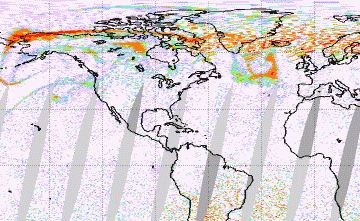
Sarychev's emissions are causing some beautiful
sunsets. Here's what to look for: When the sun goes
down, delicate
ripples of white appear over the western
horizon. The ripples are volcanic aerosols--a
mixture of ash and sulfur compounds. Then, as
twilight deepens, the sky turns a lovely shade of "volcanic
lavender." Lavender is what you get when you mix
blue light scattered by fine aerosols with ordinary
red sunset rays.
Is a plume passing over your area tonight? Keep
an eye on the western sky for Sarychev sunsets.
2009 Sarychev Sunset Gallery
[See also:
2008 Kasatochi Sunset Photo Gallery]
GEO-FLARE: One night last
month, Miroslav Grnja of Bratislava, Slovakia,
opened the shutter of his camera (a Canon 400D) and
settled back to watch the stars go by. He was
looking forward to recording a nice set of
star trails--but one of stars refused to move:
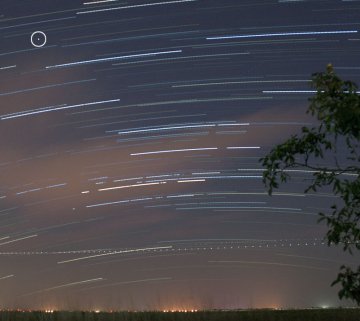
"At first I thought I had a hot pixel in my
camera," says Grnja. "Upon closer inspection,
however, I realized I had photographed a
geostationary satellite." Geostationary satellites (geosats)
remain fixed above one point on Earth's surface, so
they do not move with the stars.
Usually, geosats are too dim to show up in
star-trail photos. This one was different. "It
flared," says Grnja who made
a movie of the flash by stiching together
consecutive 90-second exposures. "The satellite
brightened to magnitude +2 as sunlight glinted from
one of its flat surfaces--perhaps an antenna or a
solar panel."
Which geosat was it? Grnja has narrowed the
possibilities to two: "E-BIRD (27948 2003-043-A) and
Intelsat 802 (26038 1997-031-A) were both in that
part of the sky during my photo-shoot." Satellite
observers may wish to keep an eye on these birds for
future outbursts.
UPDATED:
2009 Noctilucent Photo Gallery
[previous years:
2008,
2007,
2006,
2005,
2004,
2003]
Solar wind
speed: 371.3 km/sec
density: 0.6 protons/cm3
explanation |
more data
Updated: Today at 1630 UT
X-ray Solar Flares
6-hr max: B3 1350
UT Jul04
24-hr: B7 0435 UT
Jul04
explanation |
more data
Updated: Today at: 1635 UT
|
|
7-3-09 - There are no sunspots today
Current conditions
Solar wind
speed: 338.1 km/sec
density: 0.6 protons/cm3
explanation |
45 UT
X-ray Solar Flares
6-hr max: A9
2305 UT Jul03
24-hr: A9
2305 UT Jul03
explanation |
more
data
Updated: Today at:
2340 UT
Earth
at Aphelion
back to
spaceweather.com
You learned it in school, astronomers say it all the
time, it's The Truth: "Earth circles the Sun." Well...
almost.
 Earth
does go around the Sun, but not in a circle. Earth's
orbit is an ellipse, a lopsided curve with one end
closer to the Sun than the other. Earth
does go around the Sun, but not in a circle. Earth's
orbit is an ellipse, a lopsided curve with one end
closer to the Sun than the other.
On July 4, 2008, our planet is at the distant end--a
point astronomers call "aphelion." This puts us farther
from the Sun than we are at any other time of year.
"All planets in our solar system travel around the Sun
in elliptical orbits. It's Kepler's 1st Law," explains
University of Florida astronomy professor George Lebo.
"The eccentricity of Earth's orbit is 1.7%. In January
when we're closest to the Sun (perihelion), the distance
is 147.5 million km. In July we're 152.6 million km
away--a five million kilometer difference."
A distant sun means less sunlight for our planet.
"Averaged over the globe, sunlight falling on Earth at
aphelion is about 7% less intense than it is at
perihelion," says Roy Spencer of NASA's Global Hydrology
and Climate Center (GHCC).
Then why is it so warm outside?
"Seasonal weather patterns are shaped primarily by the
23.5 degree tilt of our planet's spin axis, not by
aphelion or perihelion," continues Lebo. "During
northern summer the north pole is tilted toward the Sun.
The Sun climbs high in the sky, and days are long.
That's what makes July so hot." (Note: seasons are
reversed in the two hemispheres, north and south. So
July is generally cold in the southern hemisphere.)
But there's more to the story: Says Spencer, "the
average temperature of the whole earth at aphelion is
about 4oF or 2.3oC higher than it
is at perihelion." Our planet is actually warmer when
we're farther from the Sun:
plot it!

Above: Earth's land-masses are
concentrated more north of the equator than south. Image
credit and copyright: the PALEOMAP Project.
This happens because continents and oceans aren't
distributed evenly around the globe. There's more land
in the northern hemisphere and more water in the south.
During the month of July the land-crowded northern half
of our planet is tilted toward the Sun. "Earth's
temperature is slightly higher in July because the Sun
is shining down on all that land, which heats up rather
easily," says Spencer.
Physicists would say that continents have low heat
capacity. "Consider the desert," says Bill Patzert, an
oceanographer at NASA's Jet Propulsion Laboratory. "At
night the desert is cold, perhaps only 60o F
(16o C). When the Sun rises in the morning
the temperature might jump to 100o F (38o
C) or more." Such mercurial behavior is characteristic
of materials like rocks and soil with low heat capacity.
It doesn't take much sunlight to substantially elevate
their temperature.
Water is different. It has high heat capacity. "Let's
say you went sailing off Malibu Beach at noon,"
continues Patzert. "The offshore temperature might be 75o
F (24o C) -- pretty pleasant!" What happens
after sunset? "The temperature drops, but only a few
degrees because the heat capacity of the ocean is so
high."
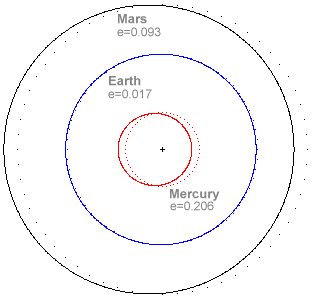 All
this explains why July is our planet's warmest month:
Northern continents baked by the aphelion Sun elevate
the average temperature of the entire globe. January, on
the other hand, is the coolest month because that's when
our planet presents its water-dominated hemisphere to
the Sun. "We're closer to the Sun in January," says
Spencer, "but the extra sunlight gets spread throughout
the oceans." Southern summer in January (perihelion) is
therefore cooler than northern summer in July
(aphelion). All
this explains why July is our planet's warmest month:
Northern continents baked by the aphelion Sun elevate
the average temperature of the entire globe. January, on
the other hand, is the coolest month because that's when
our planet presents its water-dominated hemisphere to
the Sun. "We're closer to the Sun in January," says
Spencer, "but the extra sunlight gets spread throughout
the oceans." Southern summer in January (perihelion) is
therefore cooler than northern summer in July
(aphelion).
Right:
Earth's orbit is eccentric but not nearly so much as the
orbits of Mars or Mercury. In this diagram solid lines
trace each planet's elliptical path around the Sun. The
dotted lines show circular orbits with the same mean
radius. For more information, please visit Bridgewater
College's
Interactive Planetary Orbits web site.
"Another notable difference between summers in the two
hemispheres is their duration," adds Lebo. According to
Kepler's 2nd Law, planets move more slowly at aphelion
than they do at perihelion. As a result, Northern summer
on Earth is 2 to 3 days longer than southern summer --
which gives the Sun even more time to bake the northern
continents.
If you're feeling baked, take a hint from the watery
southern hemisphere. Locate the nearest swimming pool
and dive in; feel the water's high heat capacity. A
little physics can be refreshing ....
Author: Dr. Tony Phillips
|
|
7-2-09 - No sunspots today
Current conditions
Solar wind
speed: 374.5 km/sec
density: 0.8 protons/cm3
explanation |
more data
Updated: Today at
2306 UT
X-ray Solar Flares
6-hr max: A0
2340 UT Jul02
24-hr: A0
2340 UT Jul02
explanation |
more
data
Updated: Today at:
2340 UT
MOONSHIP PHOTOGRAPHED:
NASA's LCROSS
spacecraft was 480,000 km from Earth on
Monday, June 29th, when Paul Mortfield of
Sierra Remote Observatories in California
photographed it passing by galaxy IC3808:
movie. "Amateur astronomers with
mid-sized telescopes should be able to
capture LCROSS during its cruising orbits
over the next several months before it hits
the Moon," he says. "To find it, go to the
JPL ephemeris generator and enter 'LCROSS'
as the target body."
http://ssd.jpl.nasa.gov/horizons.cgi
|
|
7-1-09 No sunspots today - the small sunspot that was
evident on June 30 has vanished. VOLCANIC
SUNSETS: The plume of volcanic
dust and sulfur dioxide that has caused so many pretty
sunsets over the USA this week has crossed the Atlantic
and reached Europe. "The purple color of the sky on June
30th was unbelievable," says Rafael Gallego, who sends
this picture from Carrión de los Céspedes, Spain:
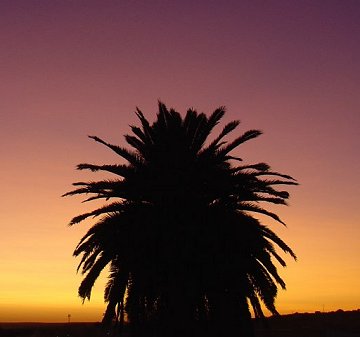
Similar reports are pouring in from France, England,
Denmark, the Netherlands, Canada and many US states.
Here's what to look for: When the sun goes down,
delicate
ripples of white appear over the western horizon.
Then, as the twilight deepens, the sky turns a lovely
shade of "volcanic lavender."
The source of the phenomenon is Russia's
Sarychev Peak volcano. It erupted on June 12th,
hurling massive plumes of sulfur dioxide (SO2)
and other debris into the stratosphere. The white
ripples that herald these sunsets are made of volcanic
aerosols--a mixture of ash and sulfur compounds. Blue
light scattered by fine volcanic aerosols combines with
ordinary red sunset rays to produce the telltale
lavender.
Earth-orbiting satellites are monitoring Sarychev's
sulfur dioxide plume as it circumnavigates the globe
at high latitudes, spreading the phenomenon from Russia
to the USA to Europe and back again. All northern sky
watchers should be alert for volcanic sunsets.
UPDATED:
2009 Sarychev Sunset Gallery
[See also:
2008 Kasatochi Sunset Photo Gallery]
ART OR
SCIENCE? Researchers at the
National Center for Atmospheric Research (NCAR) in
Boulder, Colorado, have created an unprecedented 3D
supercomputer model of a sunspot. The result is not only
scientificially informative, but also a thing of beauty:
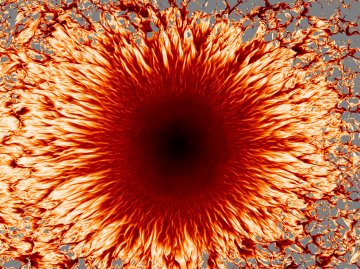

To create the virtual sunspot, researchers programmed
NCAR's IBM bluefire supercomputer with the laws of
magnetohydrodynamics, sprinkled in some ground-based
observations of actual sunspots, and hit "go." The
bluefire is capable of 76 trillion calculations per
second; even so, the program took weeks to complete. The
final model contains 1.8 billion points and covers a 3D
domain 31,000 miles by 62,000 miles wide and 3,700 miles
deep.
Physcists are now studying
movies of the virtual sunspot to develop new
insights into the dynamic behavior of these planet-sized
behemoths. More than one onlooker has gasped in
amazement when shown the surprisely lovely
subsurface structure of the 'spot.
Is it art or science?
You decide.
2009 Noctilucent Photo Gallery
[previous years:
2008,
2007,
2006,
2005,
2004,
2003]
Current conditions
Solar wind
speed: 374.5 km/sec
density: 0.8 protons/cm3
explanation |
more data
Updated: Today at
2306 UT
X-ray Solar Flares
6-hr max: A0
2340 UT Jul02
24-hr: A0
2340 UT Jul02
explanation |
more
data
Updated: Today at:
2340 UT
|




































 Earth
does go around the Sun, but not in a circle. Earth's
orbit is an ellipse, a lopsided curve with one end
closer to the Sun than the other.
Earth
does go around the Sun, but not in a circle. Earth's
orbit is an ellipse, a lopsided curve with one end
closer to the Sun than the other. 
 All
this explains why July is our planet's warmest month:
Northern continents baked by the aphelion Sun elevate
the average temperature of the entire globe. January, on
the other hand, is the coolest month because that's when
our planet presents its water-dominated hemisphere to
the Sun. "We're closer to the Sun in January," says
Spencer, "but the extra sunlight gets spread throughout
the oceans." Southern summer in January (perihelion) is
therefore cooler than northern summer in July
(aphelion).
All
this explains why July is our planet's warmest month:
Northern continents baked by the aphelion Sun elevate
the average temperature of the entire globe. January, on
the other hand, is the coolest month because that's when
our planet presents its water-dominated hemisphere to
the Sun. "We're closer to the Sun in January," says
Spencer, "but the extra sunlight gets spread throughout
the oceans." Southern summer in January (perihelion) is
therefore cooler than northern summer in July
(aphelion).

